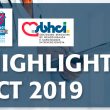Courtesy of SBHCI. Both fractional flow reserve (FFR) and optimal coherence tomography (OCT) can be useful to help define intermediate coronary lesions and optimize PCI outcomes. The FORZA study presented at San Francisco TCT 2019 scientific sessions simultaneously published in JACC randomized patients with intermediate lesions 1:1 to FFR vs OCT. For the FFR arm,...
TCT 2019 | PARTNER 3: Obvious Short-Term Quality of Life Improvement, but What Happens Afterwards?
Courtesy of SBHCI. Patients with severe aortic stenosis and low surgical risk showed decreased mortality, stroke, and heart failure hospitalization at one year with transcatheter aortic valve replacement compared with surgery. Improved quality of life may seem an obvious consequence, but until now that was mere speculation. This work, presented at the TCT 2019 Scientific Sessions...
TCT 2019 | COMPLETE: Sub-Study to Find Out Complete Optimal Revascularization Timing in STEMI
Courtesy of SBHCI. The COMPLETE study was carried out to assess the benefit of complete revascularization vs culprit vessel revascularization in the context of ST elevation acute myocardial infarction. This COMPLETE sub-study presented at TCT 2019 scientific sessions simultaneously published in JACC assessed the optimal timing of complete revascularization. The general study had already shown...
TCT 2019 | EURO-CTO: Results at 3 Years of CTO Recanalization vs. Optimal Medical Treatment
Courtesy of SBHCI. Between 16 and 18% of coronary artery lesions in patients with chronic stable CAD are chronic total occlusions (CTO). CTO revascularization could benefit symptomatic patients, but it remains unclear whether such complex procedure is safe in the long run, given the study outcomes on PCI in CAD so far. This study presented...
TCT 2019 | COAPT at 3 Years: MitraClip Reached Functional Mitral Regurgitation Target
Courtesy of SBHCI. Prognosis of patients with cardiac failure who develop secondary mitral regurgitation due to dilation is uncertain. The COAPT study was carried out in 78 centers across the US and Canada and included patients with moderate to severe mitral regurgitation (3 or 4 crossovers) symptomatic despite optimal medical treatment (OMT). 614 patients were...
TCT 2019 | EXCEL: Left Main Coronary Artery Angioplasty with Favorable Results at 5 Years
Courtesy of Dr. Carlos Fava. Unprotected left main coronary artery angioplasty with drug-eluting stents has emerged as an acceptable strategy for a select group of patients, with results comparable to those of myocardial revascularization surgery at 2 or 3 years. However, beyond such term, we had no valid information. Researchers analyzed the 5-year follow-up results for the...
TCT 2019 | EVOLVE Short DAPT: Only 3-month DATP in High Risk Bleeding
Courtesy of the SBHCI. This study used the thin strut everolimus eluting stent with ultrathin abluminal bioresorbable polymer coating chromium platinum stent, basically the Synergy stent. Drug release and polymer degradation within four months facilitate endothelization and would allow a shorter DAPT. Presented during the scientific sessions of TCT 2019, this study included 2009 high...
TCT 2019 | IDEAL-LM: Bioabsorbable Polymer DES vs. Permanent Polymer DES for Left Main Stenosis
Courtesy of SBHCI. This study showed that using the everolimus eluting stent with bioabsorbable polymer Synergy followed by 4 months of dual antiplatelet therapy (DAPT) to treat left main stenosis (LMS) was safe and effective, compared against using the everolimus eluting stent with permanent polymer Xience followed by the conventional 12 months DAPT. This study...
TCT 2019 | Onyx ONE: Durable Polymer vs. Polymer-Free Stent with Only One Month of Dual Antiplatelet Therapy
Courtesy of the SBHCI. This is the first randomized study comparing a durable-polymer drug-eluting stent (zotarolimus-eluting stent Onyx) and a polymer-free drug-eluting stent (biolimus-A9-coated stent BioFreedom), with only one month of dual antiplatelet therapy in patients at high risk for bleeding. Onyx ONE was a study conducted at 84 sites that randomized 1:1 2000 total patients at...
TCT 2019 | TWILIGHT: Minimal DAPT in High Bleeding Risk Patients
Courtesy of the SBHCI. Monotherapy with a P2Y12 inhibitor after a minimum period (3 months) of dual antiplatelet antiaggregation (DAPT) is a valid treatment option to reduce bleeding in patients at high risk of bleeding complications. The present double-blind study presented at TCT 2019 simultaneously published in NEJM analyzed ticagrelor monotherapy (prior 3 months DAPT)...
